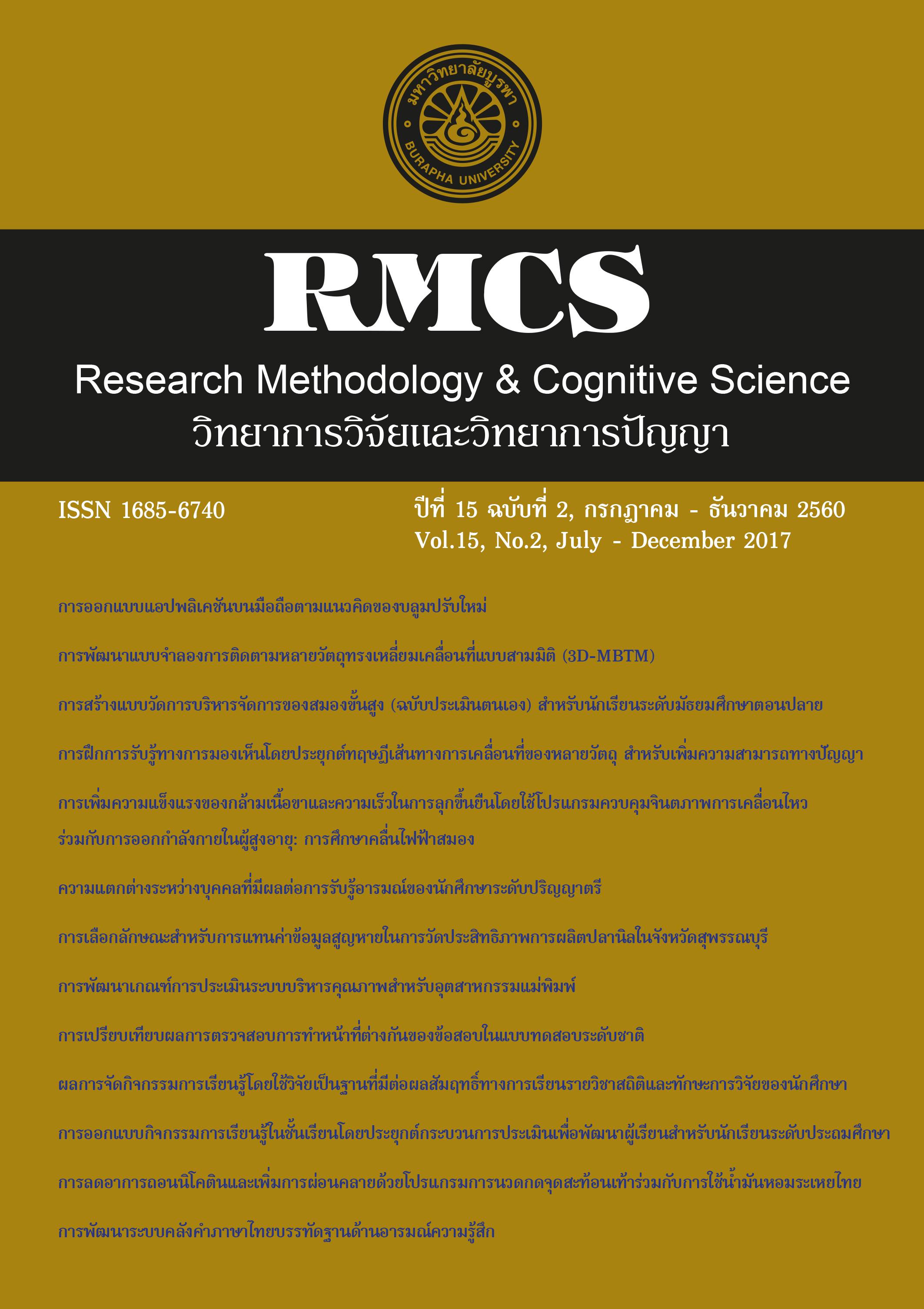Development of the Affective Norms for Thai Words (THAI-ANW) Bank System
Main Article Content
Abstract
Words are media for mutual understanding in every nationality and language. Hence, words are
stimuli which convey emotion. The objectives of this research were (1) to analyze the Thai words
of affective and to assess the quality of the affective norms for Thai words via content validity,
a discrimination index, the mean and standard deviation of Thai words, the reliability of Thai
words for three emotional domains (i.e. valence, arousal, and dominance); and (2) to develop the
affective norms for Thai words (Thai-ANW) bank system. The sample used in this study involved Thai
volunteers who lived in Thailand, and were aged between 18 and 60 years, regardless of gender,
educational level, and marital status. The sample composed of 800 people. The Self-Assessment
Manikin Scale were employed in the study, and t-tests were used to analyze the data.
It was found that;
1. A total of 528 Thai affective words were validated and retained. These words were classified
along the three emotion dimensions: 1) 211 valence words (87 pleasure, 12 neutral, and 112
unpleasure), 2) 159 arousal words (120 excited, 29 neutral, and 10 calm), and 3) 158 dominance
words (100 uncontrol, 36 neutral, and 22 control).
2. A user-friendly computerized program of the Thai Affective Words (Thai-ANW) Bank System
was developed as an online web application for housing the validated Thai affective words.
Article Details
References
อภิชัย มงคล, ยงยุทธ วงศ์ภิรมย์ศานติ์, ทวี ตั้งเสรี, วัชนี หัตถพนม, ไพรวัลย์ ร่มซ้าย และวรวรรณ จุฑา. (2560). การพัฒนา
และทดสอบดัชนีชี้วัดสุขภาพจิตคนไทยฉบับใหม่. เข้าถึงได้จาก https://www.dmh.go.th/Abstract/abstract/
abstract_detail.asp?code=100090
อัครภูมิ จารุภากร และพรพิไล เลิศวิชา. (2551). สมองเรียนรู้. กรุงเทพฯ: สถาบันส่งเสริมอัจฉริยภาพและนวัตกรรม
การเรียนรู้.
Anastasi, A. (1988). Psychological Testing. New York: Macmillan.
Bradley, M. M., & Lang, P. J. (1994). Measuring emotion: the self-assessment manikin and the semantic
differential. Journal of behavior therapy and experimental psychiatry, 25(1), 49-59. doi:
10.1016/0005-7916(94)90063-9
Best, J. W. (1977). Research in Education. New Delhi: Prentice Hall of India.
Elliott, G. (2004). Global business information technology: An integrated systems approach. Ontario: Pearson
Addison Wesley.
Ferré, P., Guasch, M., Moldovan, C., & Sánchez-Casas, R. (2012). Affective norms for 380 Spanish words
belonging to three different semantic categories. Behavior research methods, 44(2), 395-403. doi:
10.3758/s13428-011-0165-x
Gerrig, R. J., & Zimbardo, P. G. (2002). American Psychological Association: Glossary of Psychological
Terms: Pearson Education, Education, Incorporated (COR).
Huang, J., Xu, D., Peterson, B. S., Hu, J., Cao, L., Wei, N., ... & Hu, S. (2015). Affective reactions differ
between Chinese and American healthy young adults: a cross-cultural study using the international
affective picture system. BMC psychiatry, 15(60), 1-7.
Mehrabian, A., & Russell, J. A. (1974). The basic emotional impact of environments. Perceptual and Motor
Skills, 38(1), 283-301.
Montefinese, M., Ambrosini, E., Fairfield, B., & Mammarella, N. (2014). The adaptation of the Affective Norms
for English Words (ANEW) for Italian. Behavior research methods, 46(3), 887-903. doi:10.3758/
s13428-013-0405-3
Osgood, C. E., Suci, G. J., & Tannenbaum, P.H. (1957). The Measurement of Meaning. Illnois: University
of Illnois Press.
Soares, A. P., Comesana, M., Pinheiro, A. P., Simoes, A., & Frade, C. S. (2012). The adaptation of the
Affective Norms for English Words (ANEW) for European Portuguese. Behavior research methods,
44(1), 256-269. doi:10.3758/s13428-011-0131-7
Soares, A. P., Pinheiro, A. P., Costa, A., Frade, C. S., Comesana, M., & Pureza, R. (2013). Affective
auditory stimuli: adaptation of the International Affective Digitized Sounds (IADS-2) for European
Portuguese. Behav Res Methods, 45(4), 1168-1181. doi:10.3758/s13428-012-0310-1
Soares, A. P., Pinheiro, A. P., Costa, A., Frade, C. S., Comesana, M., & Pureza, R. (2015). Adaptation of
the International Affective Picture System (IAPS) for European Portuguese. Behav Res Methods,
47(4), 1159-1177. doi:10.3758/s13428-014-0535-2
Sripornngam, T., Chadcham, S., & Sudhasani, S. (2015). Development of the Thai Affective Picture Bank
System. Research Methodology & Cognitive Science. 13(2). 57-70.
Stadthagen-Gonzalez, H., Imbault, C., Perez Sanchez, M. A., & Brysbaert, M. (2016). Norms of valence
and arousal for 14,031 Spanish words. Behav Res Methods, 49(1), 111-123. doi:10.3758/s13428-015-0700-2
Stevenson, R. A., & James, T. W. (2008). Affective auditory stimuli: Characterization of the International
Affective Digitized Sounds (IADS) by discrete emotional categories. Behavior research methods,
40(1), 315-321. doi: 10.3758/BRM.40.1.315
Sun, J., Wang, G., Cheng, X., & Fu, Y. (2015). Mining affective text to improve social media item
recommendation.Information Processing & Management, 51(4), 444-457. doi:10.1016/j.
ipm.2014.09.002
Tristan, L. A. (1998). The item discrimination index: Does it work?. Rasch Measurement Transactions,
12(1), 626.
University of Florida. (2017). Retrieved from https://csea.phhp.ufl.edu/media.html
Wang, J., Yu, L. C., Lai, K. R., & Zhang, X. (2016). Locally weighted linear regression for crosslingual valence-arousal prediction of affective words. Neurocomputing, 194,271-278.
Wundt, W. (1896). Gundriss der Psychologie[Outlines of psychology].Leipzig, Germany: Entgelmann

